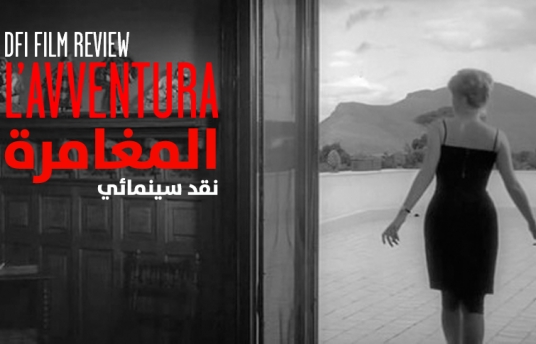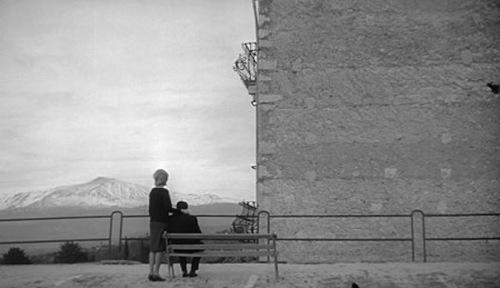DFI Film Review: L’Avventura (1960)
May 23, 2011

Written by Reem Saleh, New Media, DFI
Film: L’Avventura
Year: 1960
Director: Michelangelo Antonioni
Stars: Gabriele Ferzetti, Monica Vitti and Lea Massari
Genre: Drama, Art House & International, Mystery & Suspense, Classics
My story with this film is very personal; it marked my life. It is my personal reference, needless to say, to my sweet obsession with cinema.
Directed by Michelangelo Antonioni, the film is about Anna (Lea Massari) and her best friend Claudia (Monica Vitti) who engage in a yacht trip over the Mediterranean with Sandro (Gabriele Ferzetti), an architect who is also Anna’s lover. On their visit to one of the volcanic islands, however, they soon discover that Anna has disappeared. Their search becomes obsessive, as both Claudia and Sandro take the lead in searching for her: an investigation that brings them closer to each other, shifting the story and leading us into a new and complicated relationship. Watch trailer here
When I first watched this film as part of my class, I barely understood what all the fuss was about. To me, this 1960 winner of the Jury’s prize at the Cannes Film Festival was slow-paced with a confusing storyline, and quite uneventful. All I knew was that we were looking for Anna, and then suddenly Claudia replaces her in her relationship with the childish Sandro. So what makes it so special? I watched it again, but this time with the brilliant commentary of film critic Gene Youngblood . It gave me great insight and more: an enlightenment that forever changed my perception of cinema and storytelling. As Gene Youngblood himself said: “The first in a trilogy of films, L’Avventura’ (along with ‘La Notte’, 1961, and ‘L’Eclisse’, 1962) was concerned with the familiar post-war existential themes of alienation, non-communication, and the failure to find meaning in a world of obsolete values”.
This film is custom-tailored, measured, and multi-layered, with eloquently compacted scenes. Every frame is a composition, and when we talk composition, we talk background, frames, and every single object or imagery used in the film. For instance, Anna’s disappearance should not have been a surprise, as Antonioni left us many hints: she is always seeking windows and doors, framing herself in them like a mannequin and seeking an escape. She is restless, as if saying “I want to leave”, and just before her disappearance a tiny boat appears, in the background, leaving the island. Could it be Anna escaping? These are the kind of details that you would only notice on your second viewing, but they are there nonetheless, subconsciously suggestive. Claudia replacing her best friend’s relationship is suggested in one of the most beautiful scenes on the boat, where they exchange shirts. With one shot of their backs, it is as if they are one, erasing their identities and creating new ones.
Antonioni doesn’t use transitions much, as he prefers the image to be an actual transition instead, like moving from one scene to another through a tunnel, a gate, and through nature. The same with music: little music is used to suggest feelings and moods because the background composition is all that is needed to portray the feelings of his characters. Music should be, according to Antonioni, complimentary, but not a reason to force a feeling into a viewer – the viewer has enough space to think and understand his characters.
The last scene of the film (see image below) sums up the school of thought on this amazing director. This scene follows the development in the relationship of the new couple, who are now public, and who have been invited to a big part party. Claudia is in her room, tired, and deciding to sleep, while Sandro chooses to join the people at the social gathering. Claudia wakes up and starts looking for him, through large and empty rooms, running away… and running towards her loneliness. Suddenly, she sees Sandro with a call girl. Claudia runs outside through archways, just like Anna used to do in the beginning of the film. She is crying, devastated. She stands in front of a big tree with her back to the viewers, while the trees rustle and move with the wind, reflecting the turbulences of emotions inside her.

The last scene of the film.
Sandro, however, has followed her: he is breathless, sitting on a bench and weeping like a child. Claudia has stopped crying, and is standing up victoriously. She is the leader of this relationship now. She is the one to decide on their fate, while he looks pitiful and weak. On his side there’s nothing but a wall, but from Claudia’s side, we see an emerging volcano. She caresses his head in pity. She understands her power, and that their only way of survival together is through her pity for him. This scene, and the feelings it contain, are portrayed brilliantly by the nature around them, as well as by the composition of the image.
All through the film, Antonioni portrays Sandro as a childish and irresponsible man. He always has a very dry, architectural composition in his background – the way he is internally. He barely understands his women, and this is where Antonioni reveals one of the most important themes of this film: miscommunication. For him, women are the ones to sense when a relationship lacks understanding, or when something is going wrong. And that’s why Anna and Claudia are always portrayed in nature: they are always part of it, and are always looking for it. They are filled with complex emotions just like the trees, the mountains, and the winds that carry them.
A masterpiece indeed, ‘L’Avventura’ is a rare piece of art, preciously regarded and respected. This film teaches us that there’s more to cinema than what our eyes are used to seeing. Like a good painting, one can contemplate this over and over again.